
♦ Top page (correct Bohr model including the two-electron atoms) ♦
♦ Photons and Bell inequality violation ♦
♦ Bohr's hydrogen molecule ion (H2+) ♦
Bohr model is more useful than density functional theory (DFT).
The photon particle is said to exist. But the interference of a single photon with itself can be explained only by the wave nature of the electromagnetic (E-M) waves, NOT by the photon particle.
(Fig.1) Photon is particle or wave ?

According to QED, a single photon must be a point particle.
But in various real experiments, they often use the classical electromagnetic waves such as left-, right-circularly, vertically, and horizontally polartized lights.
Though they clearly use the property specific to the classical lights, they always try to express them as a photon particle in some papers or something.
As shown in Fig.1, if the light is a point particle, how can it be polarized or interact with other particles ?
So the concept of photon "point" particle is impossible.
(Fig.2) Entangled photon pair ?
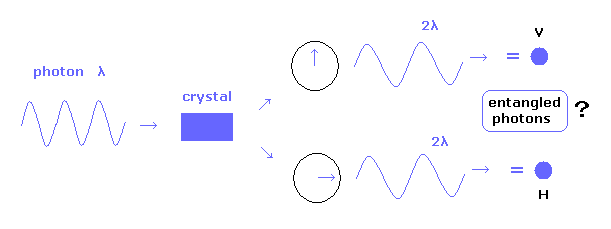
Entangled photon pair is often created by "parametric down-conversion".
In this process, a photon of wavelength λ enters some crystal, and is split into a pair of photons of wavelength 2λ.
So the total energy is conserved. (= their frequency becomes half ).
( If photon is a particle, it can be split so easily ?? )
One of the produced photon pair is horizontally polarized, and another is vertically polarized.
Though this photon pair is clearly classical electromagnetic waves, they always use the word of a "photon".
(Fig.3) Photon "point" particle can interfere with each other ?
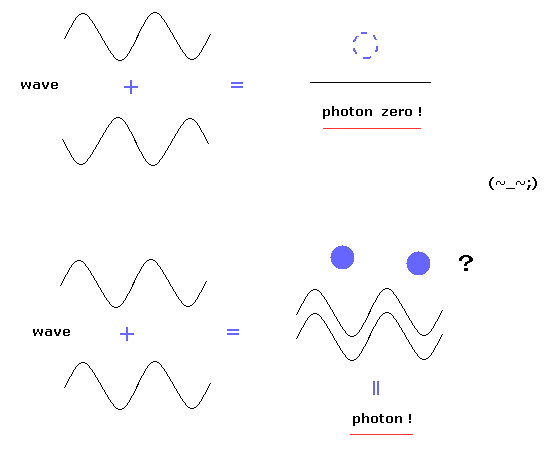
Suprisingly, photon "point" particle can interfere with each other, according to their experiments.
In Fig.3 upper, due to the destructive interference between photons, they vanish !.
Conversely, in Fig.3 lower, due to the constructive interference, the number of photons (= amplitude ) has increased, they insist.
But as shown in Fig.3, these interferences prove that what they call "photon" is clearly classical waves.
(Fig.4) Single photon detector shows photon is particle ?
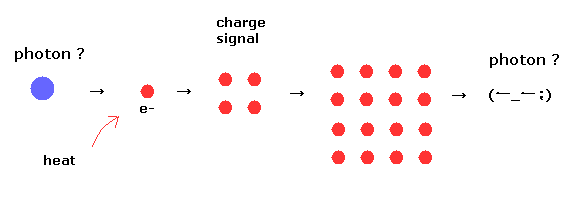
First, we cannot generate single photon directly.
By weakening coherent laser and seeing their electric current signal at photon detector, we only estimate their existence.
This detector cannot always detect photon ( < 60% ), when it enters, and due to dead time, cannot discriminate between a single and two photons.
Of course, as we cannot see directly a single photon, this photon's concept is only speculation.
Repeating photoelectric effect, photon detector increases electric current signals from a single photon.
Considering light loss in these processes, it is natural that we think photon detector can show current signal, when the light intensity is above some threshold.
(Fig.5) Mach-Zehnder interferometer.
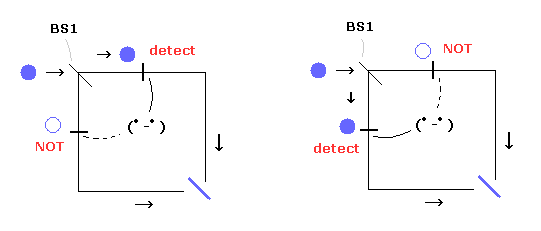
In the Mach-Zehnder interferometer, when one photon is split into the two different paths at the beam splitter (= BS1 ), we can detect one photon only in one of the two paths at the same time (= Fig.5 ).
( This means that this single photon particle is NOT split into two, according to the quantum mechanical interpretation. )
(Fig.6) Interference of a single photon.
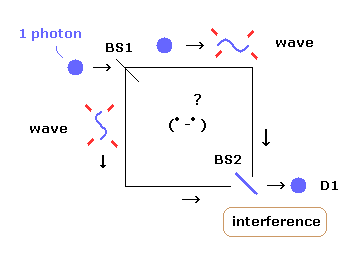
But the interference of electromagnetic waves from these two different paths is actually observed, though a single photon exists only in one of the two paths. It is amazing!
It is said that this strange phenomenon is caused by the superposition of one photon in the two different paths.
But is it really so?
This "superposition" has NO reality, because it is equal to "many fantasy worlds". (= world A and world B in this case. )
(Fig.7) Photon = classical electromagnetic waves !
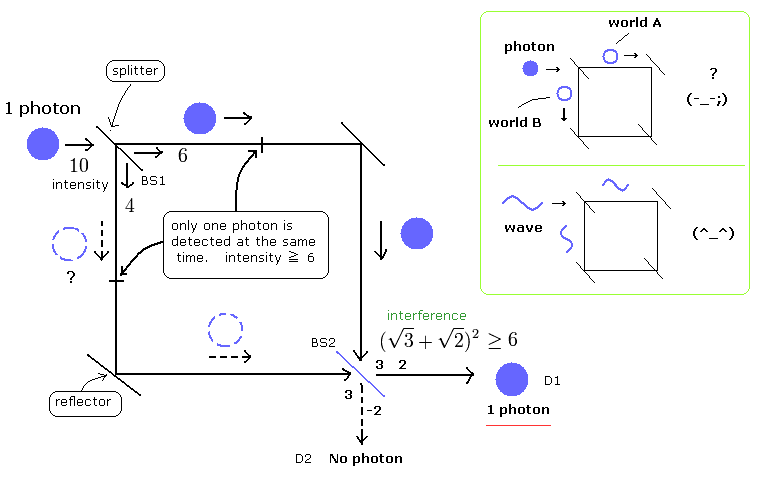
For example, in case of the 50/50 beamsplitter ( BS1 ), if the E-M waves is split into 5 + 5, no photons can be detected. (This case is not recognized at all, so it can be ignored. )
We can recognize the photon existence only when we detect it as a photon.
50/50 beamsplitter divides unpolarized electromagnetic waves into about half on average.
Depending on the polarization and frequency of the light at the beamsplitter, this probability changes.
(Fig.8) Beam splitter 2 ( BS2 ).
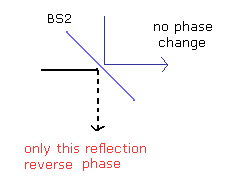
After splitting at the beam splitter 1 (BS1), both the electromagnetic waves are split into almost half also by the beam splitter 2 ( BS2 ).
( For example, 6 → 3 + 3, 4 → 2 + 2 )
In this experiment, only one side reflection is supposed to reverse light phase at the beam splitter 2 (BS2), as shown above.
( The transmitted lights are not changed. )
So at the photon detector 1 (D1), the light amplitude is increased by constructive inteference, and can be recognized as a photon.
Because the light intensity at D1 always reaches "6" by the inteference.
(The light amplitude is a square root of the light intensity.).
[ One photon "always" detected at D1 by the interference. ]

On the other hand, at the D2 detector, the light amplitudes from the two paths cancel each other, so it can not be detected as a photon.
( The light intensity at D2 side does not reach "6". )
[ At D2, no photon is detected by the interference. ]

Of course, also when the first light "10" is split into 5 + 5 at the beam splitter 1, this result is the same as the above.
In this case the light intensity "5" is split into 2.5 + 2.5, so at D1 side,

And at D2 side,

In these cases, the total energies are conserved. ( 10 → 10 ).
As a result, we can explain all these phenomena by classical electromagnetic wave model.
So they don't need the concept like "photon particles" at all.
( See also Delayed choice experiment is real ?. )
(Fig.9) Delayed choice experiment.
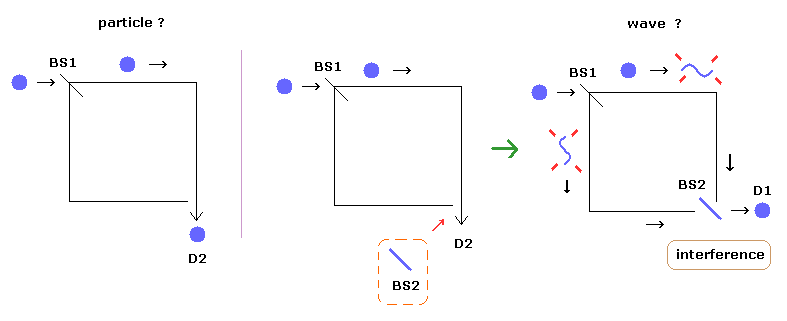
In the delayed choice experiment, after a single photon has passed through the beam splitter 1 (= BS1 ), that single photon has entered into one of two paths.
Actually, by the photon detector, only one photon is detected ( for example, at D2 in the upper figure ).
What will happen, when we insert the beam splitter 2 (= BS2 ) after the photon has passed BS1 ?
Surprisingly, in this case, the electromagnetic waves suddenly appear in the two different paths, and interfere with themselves ! (= right panel of the upper figure. )
So we can choose the past event (= particle or wave ) from the future (= delayed choice ) !
Of course, in this real world, it is impossible.
So as I said above, the concept of a single photon itself is wrong.
( Unfortunately, ordinary people do not know about these strange things related to "photon" well . )
(Fig.10) Photon spin is really " 1 " ?
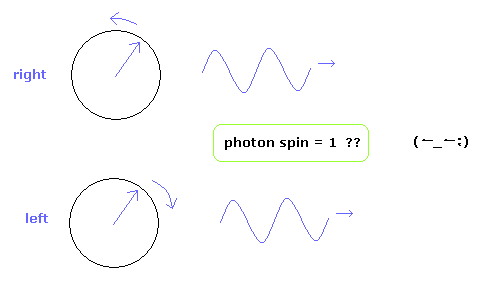
One photon is said to have "spin" ±1. What in the world is the "photon spin 1"?
The ordinary textbooks say that the photon spin ±1 correspond to the electromagnetic (E-M) waves with left and right circular polarization.
And the "linear" polarization corresponds to the superposition of these two states.
But this superposition state is very strange and difficult to imagine.
The quantum mechanics often uses a mathematical trick like this.
Then we can take this convenient word "superposition" in every situation arround us!
(e.g. when some things in different states are only mixed, when one thing is "vibrating" very fast, when one thing only keeps still....).
This means that the superposition itself is meaningless.
(Fig.11) Fine-structure = "photon" spin 1 ??
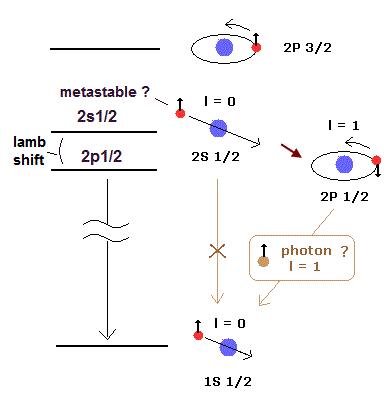
To begin with, how this photon spin 1 was discovered ?
In 1910's, the fine structure of the hydrogen atom meant the relativistic energy difference between the 2S and 2P states of Bohr-Sommerfeld model.
But after the electron spin appeared, the interpretation of this fine structure was changed to the spin-orbital interaction ( = the energy difference between 2P1/2 and 2P3/2 of the hydrogen atom. See this page. )
"Accidentally" this value coincided with that of the Bohr-Sommerfeld model !
So the "unnecessary" transition ( = 2S ---> 1S) needs to be forbidden to explain the spectrum results of the hydrogen with electron spin.
Then the selection rule (2S --x--> 1S) was introduced, and they made the photon spin 1 which probably causes this selection rule.
This means that the photon spin 1 is only an artificial thing.
(Fig.12) Point particle = photoelectric effect ??
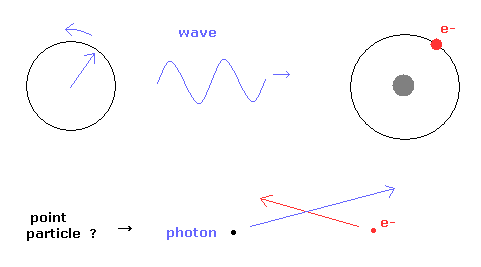
It is said that the photoelectric effect needs the concept like "photon particle". But is it really so?
The electrons are always accompanied by the de Broglie's waves around them. And it synchronizes with the electron's momentum. So we must consider the de Broglie's waves rather than the very small point-like electron in case of the photoelectric effect or the Compton effect.
Actually, circularly or linearly polarized electromagnetic waves are emitted from exicited atoms in the experiments.
And Willis Lamb himself, who was great experimentalist dealing with the light, did NOT believe photon particle.
Recent interesting studies indicate that a single photon consists of electromagnetic waves ( in both two slits ) in the weak measurements.
(Science 2011, 332, 1170, S.Kocsis et al., Nature 2011, 474, 188, J.S.Lundeen et al.)
(Fig.13) Frequency = photon particle is oscillating ?
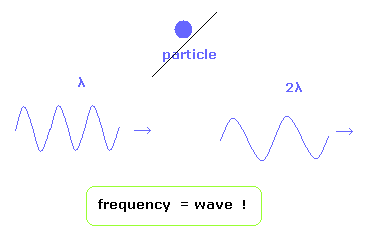
The ordinary textbooks often say that the relation between the photoelectric effect and the wave's frequency shows the particle's nature of the photon.
First, the frequency itself is based on the electromagnetic wave nature !
Second, when we heat the air or the water which give rise to "sound wave" or "wave", the frequency of each particle in those waves is increased.
So it is quite natural that the energy is related to the frequency.
( Frequency, amplitude = wave nature ! )
In the Compton effects, if the light is a particle, its velocity would change instead of its frequency, when its momentum changes.
As I said above, the frequency itself is based on wave nature.
(Fig.14) "Convenient" photon can pass through dark energy, matter, Higgs "uninjured"?
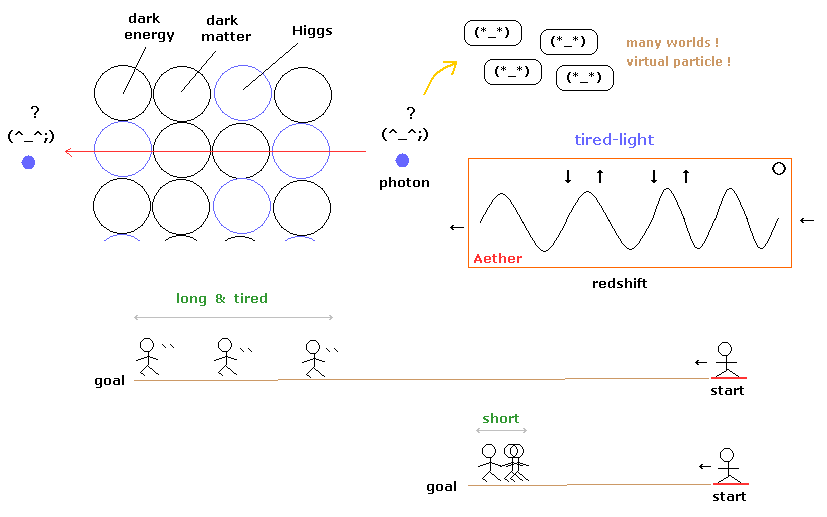
As shown in this page, photon particle needs to have strange ability to go through very crowded space "uninjured" for very long time.
Redshift by expanding universe is thought to be caused by the tired light, in which the light loses energy while it is going through the space.
The shining duration from supernova is more elongated from farther stars.
You can imagine this reason from the difference between "marathon" and "100-meter race".
And the concept of photon particle is the origin of many-world interpretation and virtual photon, which violates relativity. ( See this page. )
Suppose the light source emits the electromagnetic waves or photons to the universe. (Fig.1).
(Fig.15)
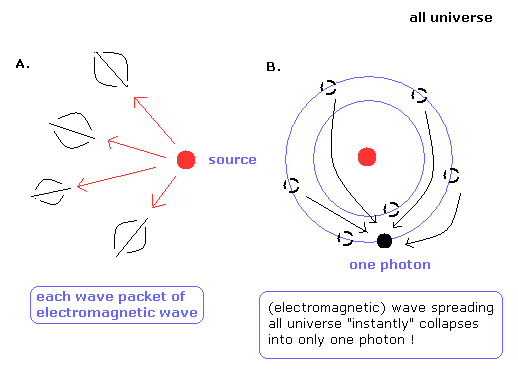
It is very unnatural that the electromagnetic waves are spreading into the universe equally and endlessly.
It is natural that the electromagnetic waves emitted by the sourse are a little unequally distributed, which becomes more conspicuous as they spread over more area.
It travels through the space as a wave packet. (Fig.15A.)
As a result, we can detect each wave packets of the electromagnetic waves from the universe.
How about the photon particle ?
According to the quantum mechanics, the probability waves (= electromagnetic waves) of a single photon are spreading into the universe equally and endlessly.
And when we detect the photon particle at some point, the electromagnetic waves in all space "instantly" collapse into only one photon ! (Fig. 15B.)
So this photon model can not be acceptable, and the electromagnetic wave model of Fig.15A is thought to be more natural.
And as I said in the page Photons and Bell inequality violation , if the photon is a indivisible particle, the strange nonlocal phenomena such as the entanglement are actually occurring, and we must believe this faster-than-light transmission. In other words, if the photon is a dividable electromagnetic wave, we need not consider this fantasy. You can easily judge which case (photon is a particle or wave) is more natural.
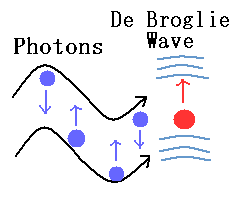
In the Bohr model hydrogen, the ground state orbit is one de Broglie's wavelength, as follows,
(Eq.1)

And in this orbit, the electron's frequency can be expressed as velocity / orbital length, as follows, (using Eq.1)
(Eq.2)

where we use the next relation,
(Eq.3)

In the hydrogen's circular orbit, the kinetic energy (T) is equal to the absolute value of the total energy (E).
In the photoelectric effect, when we illuminate the hydrogen atom by the electromagnetic wave with the energy of
(Eq.4)

the electron is emitted from the hydrogen atom.
The electron's frequency (Eq.2) is just twice the light frequency (Eq.4).
Considering the fact that the electron's kinetic energy (T) also contributes to the photoelectric effect, this result is acceptable.
If we try to keep the original electron's velocity in the emitted electron, the necessary light frequency becomes
(Eq.5)

Eq.5 is just equal to Eq.2 !
So the electromagnetic wave vibrates the electron's motion. (Their cycles are the same in Eq.5.)
The result of Eq.2 and Eq.4 (Eq.5) means that the Planck's constant (h) in the photoelectric effect is related to the de Broglie's wave !
So it is very natural that we think the photoelectric effect is caused by the electromagnetic wave and de Broglie's wave.
About the photoelectric effect by the electromagnetic wave, see also this page.
--------------------------------------
If we solve the usual Maxwell's equations, we can get the next relations.
(Eq. M-1)
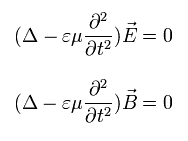
where the following relations are satisfied.

From the above equations, we can get the solutions of electromagnetic waves "naturally" (Eq.6).
For example, the electromagnetic wave which travels in the z direction is composed of the changing electric field (E) and magnetic field (B) of
(Eq.6)


Eq.6 are solutions of the above equations of Eq.M-1.
As shown in Eq.6, the amplitudes of E and B in the original electromagnetic waves are not attenuated at all.
But if we consider the old equations of the accelerated charge, the amplitude of the electromagnetic waves are attenuated, as follows,
(Eq. M-2)
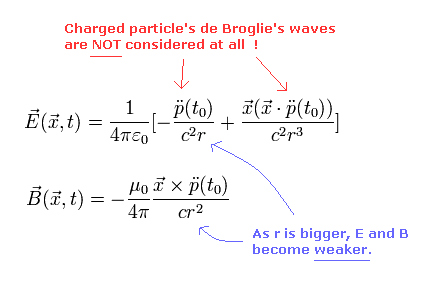
where p means the electric dipole.
And the "accelerated" dipole (p) radiates the electromagnetic wave in Eq.M-2
As the distance (= r) between this dipole and a point beomes longer, the amplitude of E and B becomes weaker as shown in Eq.M-2.
Why is this result of Eq.M-2 different from Eq.6 ?
The important point is that Eq.M-2 doesn't use the concept of de Broglie's waves at all !
Though every moving particle causes de Broglie's waves, why does Eq.M-2 neglect this thing ??
This is the reason why we misunderstand about the electromagnetic waves.
Especially in the atoms, we have to think about the quantization of de Broglie's waves !
If so, the electromagnetic wave (packet) is a little unequaly emitted, and not attenuated as shown in Eq.6.
In the old classical Maxwell equation, the energy density (u) of this electromagnetic wave is expressed as
(Eq.7)

But the energy density equation of Eq.7 has some defects.
According to Eq.7, the angular frequency (ω) doesn't contribute to the energy at all. (at the atomic level.)
Even if we change the angular frequency of Eq.7 as follows, the total energy doesn't change at all !
(Eq.8)

[ These energies of the electromagnetic waves are the same ?? ]
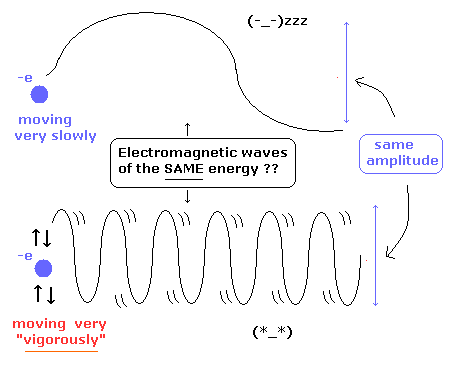
where the upper electron is swaying very slowly, and the lower electron is vibrating very vigorously.
And they have the same amplitude.
According to the interpretation of Eq.8, these energies of the electromagnetic waves are completely the same !
It is irrational.
This means the energy density of Eq.8 is incomplete.
So we need to improve the old idea about the photoelectric effect.
Basically, the frequency itself is clearly wave's nature ! ( It is not a particle's nature .)
It is quite natural.
And if we consider the frequency in the electromagnetic waves, we don't need to use the concept of photons at all.

2010/3/27 updated. Feel free to link to this site.